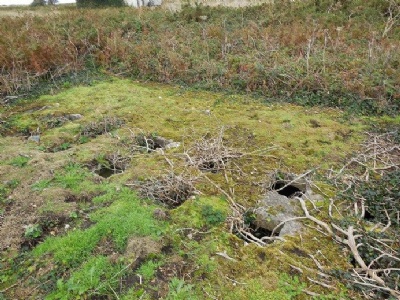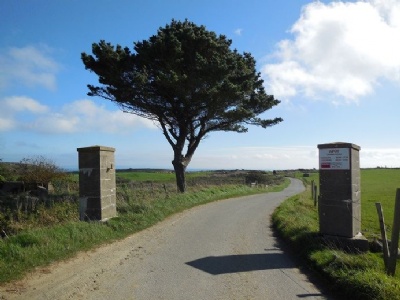Alderney - Sylt
Just off the north coast of France are the English channel islands Jersey, Guernsey and Alderney. The latter is just about ten kilometres from the French mainland. The islands were evacuated by the british in June 1940 and around the turn of June/July they were occupied by the germans. But Hitler was convinced the the British were planning to recapture them for propaganda reasons. In order to prevent a British invasion of the channel islands, Hitler decided in October 1941 that the islands would be fortified and rendered impregnable, in particular Alderney came to be heavily fortified in comparison with the other islands. The task of building the defence facilities fell on organization Todt (O.T.), which previously built the West Wall along the German border with France. The actual construction of the fortresses was largely carried out by slave workers brought from all corners of Europe. These were put in one of the four labor camps established at Alderney in 1942.
The camps were named after islands in the North Sea, Helgoland, Borkum, Nordeney and Sylt. Helgoland was located on the northwestern part of the island and consisted of about 1500 Soviet prisoners of war. In March 1944, they were moved to Nordeney, then the camp was demolished. Borkum on the southern part of the island consisted mainly of skilled workers/slave workers from Germany and from German-occupied countries. After the war, the camp was taken over by the British army before it was destroyed. Nordeney was located on the northeastern part of the island and consisted of Soviet prisoners of war and prisoners from France, Czechoslovakia, Netherlands, Spain and Germany. The capacity of the camp was about 1500. The fourth labor camp was Sylt, which was located on the southwestern part of the island and was the smallest of them all. The camp consisted of mainly Soviet prisoners of war.
In March 1943, Sylt was handed over to the SS, which in the same month moved about 1000 prisoners from Sachsenhausen and Neuengamme to Sylt. The camp was subordinated Neuengamme and thus became the only concentration camp to be established on British soil. The camp commandant was the SS-Hauptsturmführer, Maximilian List, and he ran the camp like his counterparts on the European continent. In all the camps, there was the lack of food, lack of medicines, lack of healthcare, harsh weather, lack of sanitary facilities, spread of diseases and the constant fear of the arbitrary actions of the guards were always present. Sylt was dismantled and demolished in June 1944. The total number of prisoners in all four camps is about 4,000. How many died is difficult to estimate, but in Sylt the number of prisoners who died is believed to be about 400.
Current status: Demolished with memorial tablet (Sylt) (2013).
Location: 49° 42' 18.16" N 2° 13' 10.15" W (Sylt)
Get there: Cycle.
Follow up in books: Sanders, Paul: The British Channel Islands Under German Occupation 1940 – 45 (2005).
























With the exception of Sylt, there are no memorials and the memorial tablet at Sylt was put up as late as 2008. In the vicinity of Nordeney there is a common memorial (Hammond memorial) for all the prisoners who were brought to Alderney. Sylt is otherwise the most interesting camp to visit. The camp entrance remains, even some ruins of various buildings remain, preserved are also two shelters for SS staff, two small guard shelters and an underground tunnel that connected the commandant’s villa with the camp. With the exception of the camp entrance, the site is covered with dense vegetation and thorny shrubs that makes it difficult to wander around the area. The underground tunnel is more or less impossible to find if you do not know where to look. In order for visitors to get an idea of what the camp looked like, it would be a good idea to put up an information board. At Helgoland, the camp entrance remains, while the rest of the camp area now houses residences. At Borkum, the camp entrance remains and some foundations. At Nordeney the prisoners’ kitchen and the commandant’s villa remain. Both are located on private land and have undergone renovations over the years. Other parts of the former camp area are now a camping area. All sites can easly be reached by cycle.
My feeling is that British authorities do not really want to acknowledge the fact that British territory was occupied by the germans and that there was actually a concentration camp on British soil. I believe that the British want to preserve the collective memory of a Britain not occupied and that they therefore want to keep the channel islands at distance. However, there are museums and monuments on all the islands as a reminder of the German occupation.
What happened to the Jews who were on the islands? When the Germans occupied the islands, there were seventeen Jews living there.Some Jews had left before the germans arrived. However, the British government only allowed British Jews to evacuate meaning that Jews with foreign passports were left to their fate. In connection with the occupation, the germans demanded that all Jewish passports be stamped with the letter J. The local police and local authorities cooperated with the germans on the jewish question, making it easier for the germans to identify Jews and Jewish property. This cooperation led to the arrest and deportation of Marianne Gruenfeld from Poland, Therese Steiner and Auguste Spitz, both from Austria, in April 1942, to France and later to Auschwitz where they were murdered.